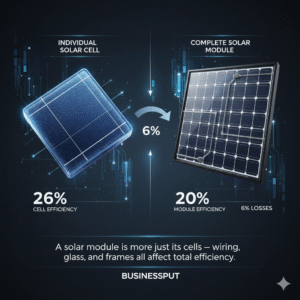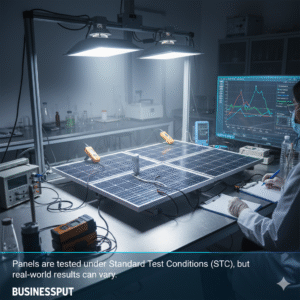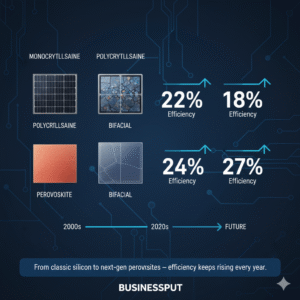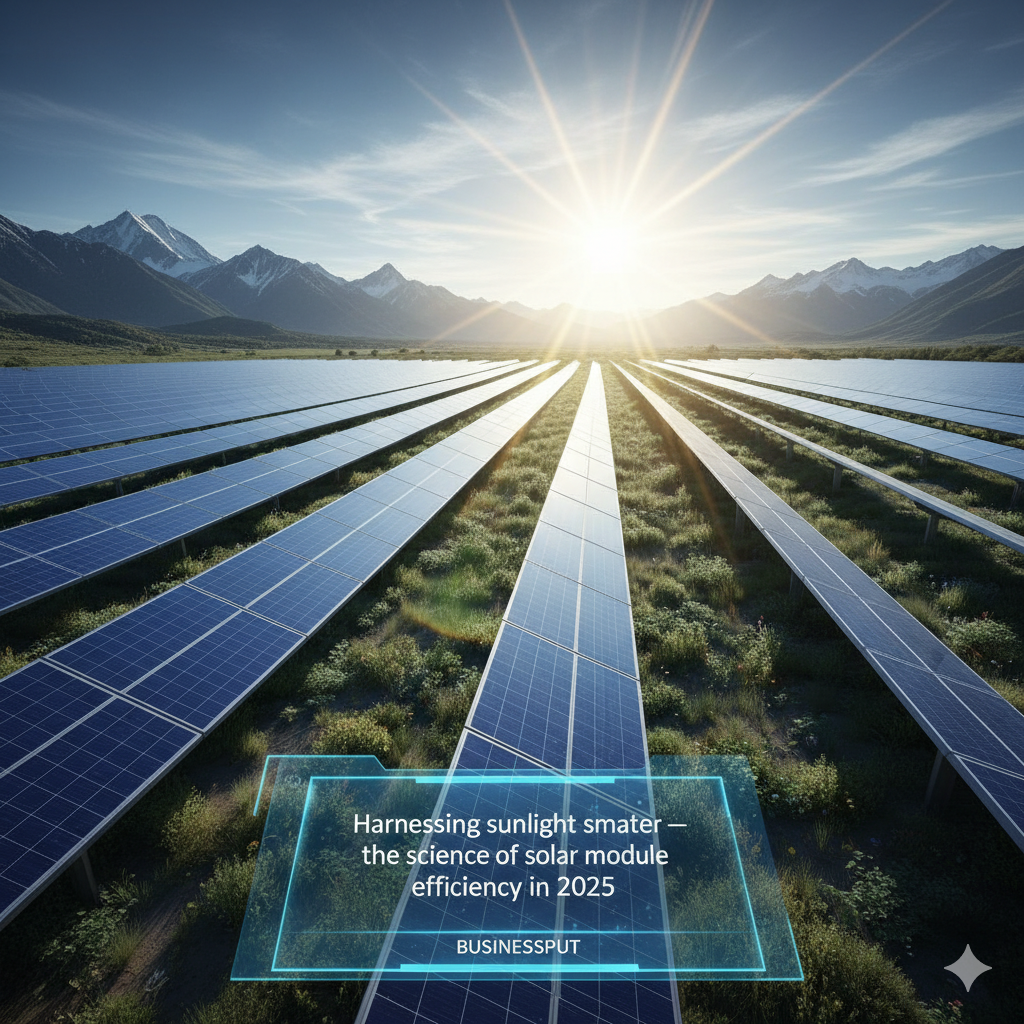⚡ Solar Panel Module Efficiency: The Secret Behind Powerful, Smarter Solar Energy in 2025
🌍 introduction: The Reasons Behind Everyone’s Discussion on Module Efficiency
There is no stopping the solar revolution. People all across the world are converting rooftops into miniature power plants, whether they are in large industrial facilities or small-town residences. ☀️ However, one question continues coming up: why do certain solar panels, despite having the same appearance, produce more electricity than others?
Module efficiency, a small percentage figure with enormous significance, holds the key to the solution.
Simply said, module efficiency indicates how well a solar panel generates power from sunlight. More power from the same amount of sunshine is possible with more efficiency, which results in greater savings, quicker payback, and a lesser environmental impact. 🌿
However, there is more to the tale. Module efficiency is more than simply the number on a panel; it’s also about how your system performs in the real world. Factors like heat, dust, shading, and even installation technique all have a significant impact.
Let’s examine module efficiency’s science, technology, and real-world magic in a way that is accessible to all.
☀️ What Exactly Is Module Efficiency?
The percentage of sunlight that your solar panel can transform into electrical energy that can be used is known as module efficiency.
Imagine a single square meter of your solar panel receiving 1000 watts of sunlight.
Your panel’s efficiency is 20% if it produces 200 watts.
Thus, one-fifth of the sunlight is converted into energy by a 20% efficient solar module, with the other portion either becoming heat or being reflected off the surface.
To put it simply, more efficiency translates into more electricity per square meter.
Module efficiency is therefore essential if:
Your roof space is restricted. 🏠
You want every ray to have as much power as possible ☀️

🧩 Cell Efficiency vs. Module Efficiency: The Hidden Difference
When researching solar panels, you’ll often see two numbers — cell efficiency and module efficiency.
Although they sound similar, they aren’t the same:
| Term | What It Means | Why It Matters |
|---|---|---|
| Cell Efficiency | Efficiency of an individual solar cell | Reflects lab-level performance |
| Module Efficiency | Efficiency of the entire panel, including all components | Reflects real-world usable output |
Because a solar module is made up of more than just cells, there is a gap. It has gaps, connectors, wiring, glass, and a frame, all of which produce minute losses.
Therefore, even if a cell has an efficiency of 25%, the entire module may only achieve about 22%.
Isn’t that still impressive? 💪
⚙️ How Module Efficiency Is Measured
Standard Test Conditions (STC) are used by manufacturers to ensure that panels can be fairly compared.
This is what that implies:
Sunlight intensity, or irradiance, is 1000 W/m².
25°C is the cell temperature.
Air Mass (AM): 1.5, which is the amount of sunlight that normally filters through the atmosphere.
However, such is not always the case in real life. Because of changes in lighting, temperature, and shadows, your real-world efficiency may vary.
Because they demonstrate performance under more realistic circumstances (about 45°C panel temperature, mild wind, and 800 W/m² sunshine), NOCT (Nominal Operating Cell Temperature) ratings are particularly significant.
🌤️ Pro Tip: Before making a purchase, always check the STC and NOCT numbers since these provide insight into the panel’s actual performance on your rooftop.
🧠 Why Module Efficiency Matters More Than You Think
Module efficiency affects:
-
✅ How much energy you generate per day
-
✅ How many panels you need
-
✅ How much space your system takes
-
✅ How fast you recover your investment
- For instance, if two homes install 5kW systems, one of whom uses 17% efficient panels and the other 22%, the second homeowner can use fewer panels to generate more power while saving money on wiring and mounting hardware.
💡 Typical Efficiency Ranges in 2025
| Technology | Efficiency Range | Highlights |
|---|---|---|
| Monocrystalline | 20–23% | High efficiency, sleek look, best for limited space |
| Polycrystalline | 15–18% | Budget-friendly, but less efficient |
| PERC | 19–22% | Enhanced rear surface for better light capture |
| Bifacial Panels | 21–26% | Generate power from both front & back sides |
| HJT / TOPCon | 22–24% | Cutting-edge, low degradation, excellent for hot climates |
| Perovskite Tandems | 26–30%+ (lab) | Next-gen technology, expected to dominate by 2030 |
🚀 Did you know? The world record for lab-tested solar efficiency has already crossed 33% using tandem technologies — a glimpse of the future!
🔥 Real-World Factors That Affect Efficiency
Physics is unavoidable, even for the most sophisticated panels. The real efficiency of your system is greatly influenced by these factors:

1. Temperature
Solar cells detest heat!
Voltage decreases and panels generate less electricity as the temperature rises.
As the temperature rises over 25°C, most panels lose 0.4 to 0.5% of their efficiency.
Performance is therefore decreased in desert sites or on roofs with little ventilation.
✅ Advice: To promote airflow and avoid heat accumulation, keep panels slightly raised.
2. Angle and Intensity of Sunlight
Power output fluctuates during the day, as does the amount of sunlight.
Less energy is absorbed by panels when sunlight strikes them at a low angle in the morning or evening.
✅ Tip: For optimal year-round exposure, position panels facing south (in the northern hemisphere) at an inclination corresponding to your latitude.
🧽 3. Dirt and Dust
Up to 10% less energy can be produced as a result of dust, pollen, or bird droppings.
For this reason, automatic cleaning systems are a feature of solar farms in arid regions like Rajasthan or Arizona.
✅ Tip: For reliable production, clean panels every three to four months or during dust storms.
4. Shading
Because cells in a series circuit behave like Christmas lights, if one is dim, the others suffer. This means that even partial shadowing (from trees, chimneys, or adjacent buildings) can significantly lower output.
✅ Advice: To reduce shading losses, use power optimizers or microinverters.
5. Degradation & Age
Over time, all panels deteriorate, usually by 0.5% annually.
This implies that your panel will continue to function at roughly 87–90% of its initial output after 25 years.
✅ Advice: Always review the degradation warranty; reputable manufacturers promise a loss of less than 0.4% year.
⚡ Strategies to Increase the Efficiency of Your Solar Panels
The sun cannot be changed, but your setup may be optimized! 🌞
✅ 1. Install Smart
Choose the right angle and orientation for your region. Even a 10° difference can impact output significantly.
✅ 2. Use MPPT Inverters
Maximum Power Point Tracking inverters continuously adjust voltage and current to extract the highest possible power.
✅ 3. Go Bifacial (If Possible)
If you have reflective surfaces (like white roofs or gravel), bifacial panels can boost total energy yield by up to 15%.
✅ 4. Cool It Down
Natural airflow, reflective coatings, or water cooling in industrial setups can reduce thermal losses.
✅ 5. Keep It Clean
A monthly wipe-down can bring back up to 5–10% lost energy — an easy win!
The Cost vs. Efficiency Debate
It’s simple to believe that “better” equates to “more efficient.” The reality is that it depends on your circumstances.
If you’ve got:
Insufficient roof space → The expense of high-efficiency panels is justified.
Plenty of room -> You can save money with moderately efficient panels.
If you can fit more of them, the somewhat less expensive 18% panel might occasionally provide the same overall output for less money.
The Golden Rule: The cost of each kilowatt-hour over the system’s lifespan, or LCOE (Levelized Cost of Electricity), should always be used when comparing panels.
🔮 Module Efficiency‘s Future: What Comes Next?
The competition to create more intelligent, affordable, and effective solar panels is intensifying! 🔬
1. Tandems of Perovskite and Silicon
More of the solar spectrum is captured by perovskite layers placed on top of silicon cells; in lab settings, this efficiency can surpass 30%. By 2030, these should be available in commercial markets.
2. The Revolution of Bifacial
Large-scale solar farms are currently dominated by bifacial panels, particularly in desert or snowy areas where reflected light adds free energy.
3. Intelligent Materials & Cooling
Energy yields are being increased without the need for additional hardware thanks to self-cooling panels, nanocoatings, and AI-driven tracking systems.
4. Environmentally Friendly Production
Solar is becoming more greener as manufacturers switch to recyclable silicon and lead-free perovskites.
🧠 Common Myths About Solar Efficiency (Busted!)
🚫 Myth #1: “Higher efficiency panels always produce more power.”
✅ Truth: Depends on sunlight, temperature, and installation quality.
🚫 Myth #2: “Solar panels stop working on cloudy days.”
✅ Truth: Panels still produce 10–25% of normal output — diffuse light still counts!
🚫 Myth #3: “Efficiency doesn’t change over time.”
✅ Truth: Panels slowly degrade — but with proper care, they last 25–30 years easily.
A Real-World Example
Assume that a 5kW solar system with 20% efficiency panels is installed.
A space of about 25 m² is required.
You may generate the same amount of energy with fewer panels if you select 23% efficient panels, which will only require 22 m².
However, unless you have limited space, the additional expense of those 30% more expensive high-efficiency panels might not outweigh the savings.
For this reason, it’s crucial to balance cost, efficiency, and long-term yield.
Impact of Sustainability: Why Every Percent Is Important
Each 1% increase in module efficiency translates into:
Reduced land usage 🌱
Reduced consumption of materials ♻️
The same sunlight yields more energy 🌍
This translates into less carbon emissions, cleaner cities, and a quicker worldwide switch to renewable energy.

✅ Key Takeaways
🌞 Module efficiency = sunlight-to-electricity conversion.
💡 It determines how much energy your system produces per square meter.
💧 Temperature, shading, and dirt can reduce performance — maintenance matters!
💸 Don’t chase numbers — choose the best balance between cost and performance.
🚀 Future tech like perovskite and bifacial modules will push solar beyond 30% efficiency.
🌅 Turning Every Ray into Power
Module efficiency is at the core of solar innovation and is not merely a technical phrase. It symbolizes humanity’s attempt to accomplish more with less, to make every photon matter and transform common rooftops into clean power plants.
We can now catch sunlight more effectively than ever before with smarter technology, careful installation, and routine maintenance, paving the way for a future driven by inexpensive, clean energy. 🌞⚡
Therefore, keep in mind that the tiny “efficiency” number on a solar panel is more than simply a number the next time you see it.
It’s a preview of a more promising and sustainable future. 💛




